The Climate In This Region Is Usually Hot And Dry, Punctuated By Sporadic Torrential Downpours. After




The climate in this region is usually hot and dry, punctuated by sporadic torrential downpours. After such events, the ground flourishes with a dense interconnected web of growth taking advantage of the temporary hydration. Once all the water dissipates, the soil is left to crack in the heat of the day. During these times Ponderosus are on the move, searching for the last remaining vernal pools. They used the times of plenty to fill up on nutrients, but now during a drought they switch primarily to photosynthesis to meet their energy needs. The smaller, dish-faced Lanx are not so lucky. Embedded in the ground unable to move, they must simply go dormant if the rains do not arrive soon enough. For now they point their open frills at the sun and gather energy while they still can. A Stealthspring prowls the scene looking for unfortunate small creatures who may not be faring well in the heat. Their predominant walking style requires a different gait for front and back sets of legs, but if needed their whole body becomes a giant spring, allowing them to burst forward for great distances. In an environment where major features like the ponderosus can move, it can be difficult to navigate from day to day, so the stealthspring must be ready to take flight at any time, should danger come calling.
More Posts from Exobiotica and Others
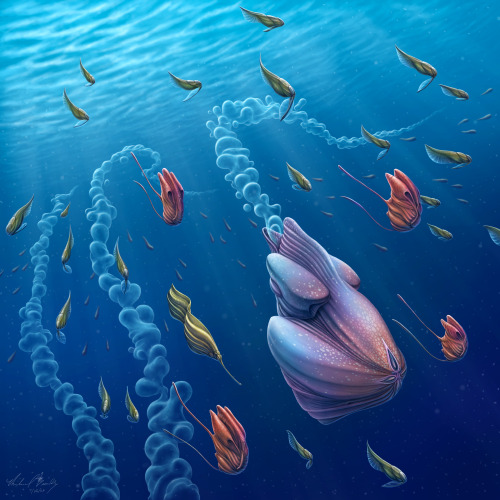
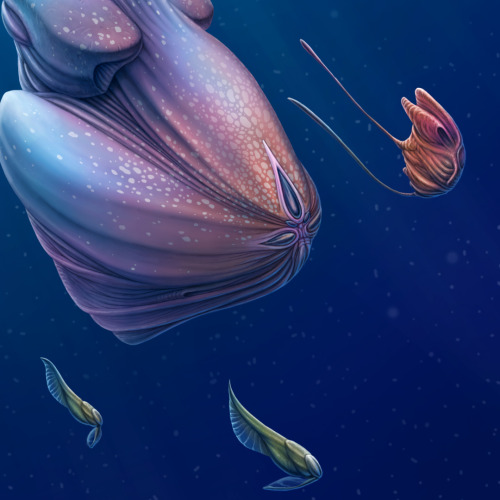
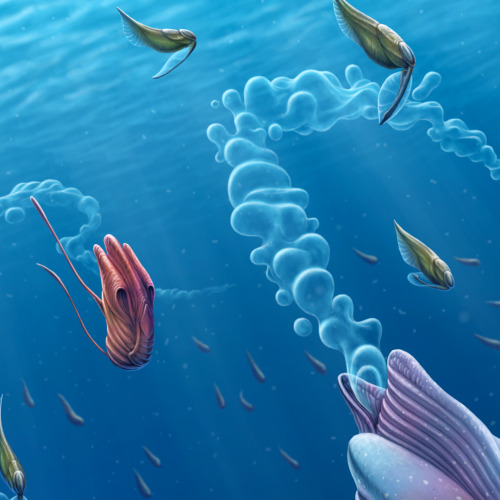
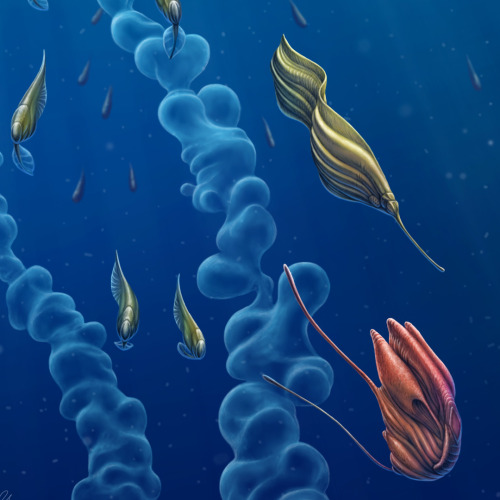
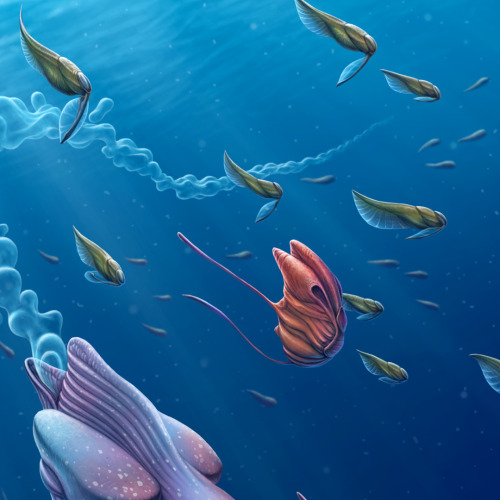
Back to the Depths
An entourage of opportunistic creatures accompanies the deep-sea behemoths during their brief ascent to the surface. Releasing their gelatinous strings of embryos here in the sunlight has a significant benefit - there's far more visibility. The swarm of followers are here in search of a quick meal in the form of the gelatin, which is full of valuable protiens and nutrients. After the feast however, the recipients of this apparent windfall become unwitting hosts for the behemoth's multitudinous offspring, which were embedded in the gel. Adapted to develop inside a wide variety of pelagic creatures, the young grow internally - and sometimes even on the surface of - their hosts until such time as they detach and sink back into the darkness. For most host species, this seems to be a mutually-beneficial symbiosis. At the beginning they receive a large and valuable meal, and usually incur very little detriment due to their temporary parasites. The young behemoths will hide in the dark depths for many years until attaining the size necessary to return to the light and repeat the ancient cycle again.




Kings of the High Desert
A herd of strange creatures has congregated on this rocky outcrop. Known as Emperor Shinebacks, they often climb these rugged foothills to obtain access to cooling breezes and additional food sources. Their top-heavy tripodal stature prevents further ascension into the mountains, but it serves them well on more level ground. Reflective carapaces mitigate much of the sun’s harmful rays, and cooling flaps along their flanks dissipate excess heat. A shineback’s normal gait is rather clumsy, but when haste is needed they clamp all three legs together into a single monopod and bounce effortlessly across the desert at remarkably high speeds. This combined with their massive size (adults are over eight feet tall) and protective social behavior makes them almost impervious to attack. Almost…

Veteris-42820 C
Finally a planet to house (most of) the creatures I've designed so far. A terrestrial planet with about 2/3 the mass of Earth, it orbits its K-type star, Veteris, within the habitable zone. This system is around 8 billion years old - about twice that of ours, hence the name Veteris, which is Latin for "old". It sits at the outskirts of the nebula behind it, which will still be busy birthing star systems for billions of years to come. Veteris is a good analog for earth- it has a similar chemical composition (including its atmosphere, which is slightly more dense - at about 1.5 atm) so it's a good place to begin our journey.
You are one of my biggest inspirations for creature design. Your aliens are beautiful and unique, and when I look at your art it feels like I’m actually there! Your art is beautiful
Thank you so much! I’m honored to be an inspiration for you.





A Giant Forest Walker






Monolith
The seasonal rains have come to the high desert. Among the first to respond is the monolith. It sends out hose-like tendrils to siphon water and turns on its biolights to attract flying symbionts.






As Above, So Below
Throughout most of the year, the nighttime skies of planet Veteris are illuminated by a vast, brilliant nebula. Tiny photosynthetic organisms multiply during the daylight hours, and after sunset the surface waters become a thick soup of predators ascending from the deep to feed on them. Any creature seen from below will be silhouetted against the glow of the sky above. To prevent becoming easy targets for predation, many blend in by producing their own light. In their swarming multitudes, these billions of incandescent swimmers create biological nebulae beneath the waves. Massive filter feeders like the ghostly white Niveus have no need for such camouflage. Their immense size and surprising speed are enough to keep them safe as they cruise these starry seas.





Full of Stars
The season's storms had taken their toll, opening up an organic cave in the otherwise sealed mountain canopy forest. Encouraged by the prospect of shelter from more incoming inclement weather, the dacia considers entering the dark, yet inviting refuge. The glittering biolights beckon, but this new environment is far stranger than anything it’s ever known.
I like your art. It is such a beautiful place and I can see Veteris being a wonderful place to explore in your art and world.
Thank you! I have a world full of ideas to bring to life, it just takes a long time.



Pelagic predator pen sketch. More on this soon.
-
 dollygarden liked this · 3 weeks ago
dollygarden liked this · 3 weeks ago -
 tophatdoggo liked this · 1 month ago
tophatdoggo liked this · 1 month ago -
 cricketbombed liked this · 1 month ago
cricketbombed liked this · 1 month ago -
 delta-trox liked this · 1 month ago
delta-trox liked this · 1 month ago -
 77-feral-cats-in-a-trenchcoat liked this · 1 month ago
77-feral-cats-in-a-trenchcoat liked this · 1 month ago -
 loopylupie reblogged this · 1 month ago
loopylupie reblogged this · 1 month ago -
 potato-gnocci liked this · 2 months ago
potato-gnocci liked this · 2 months ago -
 panicedgannet reblogged this · 2 months ago
panicedgannet reblogged this · 2 months ago -
 panicedgannet liked this · 2 months ago
panicedgannet liked this · 2 months ago -
 deathlyborb reblogged this · 2 months ago
deathlyborb reblogged this · 2 months ago -
 helphelpquesohelado liked this · 2 months ago
helphelpquesohelado liked this · 2 months ago -
 doesittho liked this · 2 months ago
doesittho liked this · 2 months ago -
 fleetxflotilla liked this · 2 months ago
fleetxflotilla liked this · 2 months ago -
 mcpieandhaggis reblogged this · 2 months ago
mcpieandhaggis reblogged this · 2 months ago -
 ironicparadox11 liked this · 2 months ago
ironicparadox11 liked this · 2 months ago -
 harkenizalone liked this · 2 months ago
harkenizalone liked this · 2 months ago -
 leviathans-vessel liked this · 2 months ago
leviathans-vessel liked this · 2 months ago -
 crionic-dubs reblogged this · 2 months ago
crionic-dubs reblogged this · 2 months ago -
 chippoxia reblogged this · 2 months ago
chippoxia reblogged this · 2 months ago -
 homeplanets reblogged this · 3 months ago
homeplanets reblogged this · 3 months ago -
 crionic-dubs liked this · 3 months ago
crionic-dubs liked this · 3 months ago -
 immunidune reblogged this · 3 months ago
immunidune reblogged this · 3 months ago -
 immunidune liked this · 3 months ago
immunidune liked this · 3 months ago -
 knavewoods liked this · 3 months ago
knavewoods liked this · 3 months ago -
 tocautiouslygo liked this · 3 months ago
tocautiouslygo liked this · 3 months ago -
 artislenosla reblogged this · 3 months ago
artislenosla reblogged this · 3 months ago -
 blueshirtsarebetter reblogged this · 3 months ago
blueshirtsarebetter reblogged this · 3 months ago -
 ginichimarutaichou liked this · 3 months ago
ginichimarutaichou liked this · 3 months ago -
 ollikiwi liked this · 3 months ago
ollikiwi liked this · 3 months ago -
 p0tat0pal liked this · 3 months ago
p0tat0pal liked this · 3 months ago -
 c-rowlesdraws liked this · 3 months ago
c-rowlesdraws liked this · 3 months ago -
 redapeguy liked this · 3 months ago
redapeguy liked this · 3 months ago -
 fallingintowrongterritories liked this · 3 months ago
fallingintowrongterritories liked this · 3 months ago -
 hyracia liked this · 3 months ago
hyracia liked this · 3 months ago -
 perromago reblogged this · 3 months ago
perromago reblogged this · 3 months ago -
 perromago liked this · 3 months ago
perromago liked this · 3 months ago -
 agathaspecbio reblogged this · 3 months ago
agathaspecbio reblogged this · 3 months ago -
 boxheadpaint liked this · 3 months ago
boxheadpaint liked this · 3 months ago -
 snoozlebee reblogged this · 3 months ago
snoozlebee reblogged this · 3 months ago -
 snoozlebee liked this · 3 months ago
snoozlebee liked this · 3 months ago -
 philipkampp reblogged this · 3 months ago
philipkampp reblogged this · 3 months ago -
 beepfish liked this · 3 months ago
beepfish liked this · 3 months ago -
 hot-cicada-milf-summer liked this · 3 months ago
hot-cicada-milf-summer liked this · 3 months ago -
 shinythingsshinythings liked this · 3 months ago
shinythingsshinythings liked this · 3 months ago -
 laconic-void liked this · 3 months ago
laconic-void liked this · 3 months ago -
 mavraani liked this · 3 months ago
mavraani liked this · 3 months ago -
 nando161mando liked this · 3 months ago
nando161mando liked this · 3 months ago -
 meonea liked this · 3 months ago
meonea liked this · 3 months ago -
 gemderplantcat reblogged this · 3 months ago
gemderplantcat reblogged this · 3 months ago